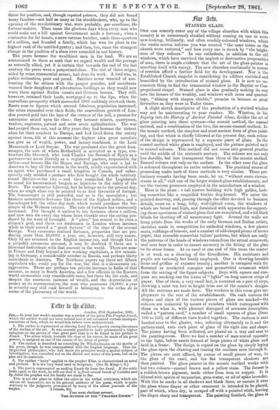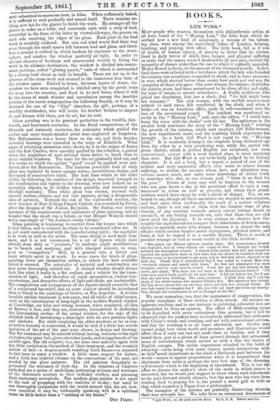fira 3rtg.
STAINED GLASS.
ONE can scarcely enter any of the village churches with which this country is so numerously studded without coming on one or more new-looking, brilliantly, and often crudely-coloured windows, which the rustic sexton informs you was erected "the same toime as the church were restored," and how every one is struck by " the bright- ness of they colours." In our cathedrals, in addition to the old windows, which have survived the neglect or destructive propensities of man, there is ample evidence that the art of the glass-painter is asserting itself with energy. The new churches continually in course of erection afford a further field for its development. Nor is the Established Church singular in considering its edifices enriched and beautified by the introduction of stained glass. It is now no un- common thing to find the ornamental window in the Baptist or Con- gregational chapel. Stained glass is also gradually making its way into the houses of the wealthy, and windows with arms and quarter- ings, "shining with shapen shields," promise to become as great favourites as they were in Tudor times.
A slight sketch descriptive of the production of a stained window may not be uninteresting to your readers. Mr. Winston, in his Inquiry into the History of Ancient Painted Glass, divides the art of
glass painting into three systems—the mosaic method, the enamel method, and a combination of the two, the mosaic-enamel method. In the mosaic method, the simplest and most ancient form of glass paint- ing, and that which is chiefly followed at the present day, each colour of the design is represented by a separate piece of glass. In the enamel method white glass is employed, and the picture painted on it in enamel colours. This method did not come into general practice until the middle of the sixteenth century. The colours are not only less durable, but less transparent than those of the mosaic method. Enamel colours rest only on the surface. In the other case the glass is coloured throughout its entire substance. The practical course of proceeding under each of these methods is very similar. These pre- liminary remarks having been made, let us, "without more circum- stance at all," visit one of the larger stained-glass establishments, and see the various processes employed in the manufacture of a window.
Here is the place : a tall narrow building with high gables, look- ing somewhat like a magnified Gothic dog-kennel. We enter the pointed doorway, and, passing through the office devoted to biminess details, come on a long, lofty, well-lighted room, the windows of which are broad and high, and furnished with apparatus for support- ing those specimens of stained glass that are completed, and with black blinds for shutting off all unnecessary light. Around the walls are hung prints from the works of the early German and Italian artists, sketches made in competition for cathedral windows, a few plaster casts, rubbings of brasses, and a number of odd-shaped pieces of brown paper, that resemble somewhat tailors' patterns, but which are really the patterns of the heads of windows taken from the actual stonework, and sent here in order to ensure accuracy in the fitting of the glass to its stone frame. At an easel at one end of this room the master is at work on a drawing of the Crucifixion. His assistants and pupils are variously but busily employed. One is drawing heraldic lions and griffins of extreme tenuity; another is occupied with the fioriated or crocketed canopies and geometrical ornament which form the setting of the figure subjects. Boys with square and com- pass are marking out the forms of "lights" on long narrow strips of paper. One of them, a very small boy, is mounted on a pair of steps, drawing a saint ten feet in height from one of the master's designs. All the cartoons are made here. The workers in this room give em- ployment to the rest of the establishment. On each cartoon the shapes and sizes of the various pieces of glass are marked—the colours are indicated by means of numbers which correspond with those on what is, with pleasant disregard of accurate description, called a "pattern card," a number of small squares of glass (from 100 to 150) of different tints leaded together. The cartoon is next handed over to the glazier, who, referring alternately to it and the pattern-card, cuts each piece of glass of the right size and shape. The pieces having been collected, are placed on a tray and sent to the painting-room. Here we find a number of men seated opposite to the light, before easels formed of large pieces of white glass and held in a frame. The design is copied on the glass by simply laying the glass upon the drawing and tracing the outlines seen through it. The pieces are next affixed, by means of small pieces of wax, to the glass of the easel, and the flat transparent shadows are then painted. The glass painter in the mosaic method works with but two colours—enamel brown and a yellow stain. The former is a reddish-brown pigment, made either from iron or copper. It is diluted with spirits of turpentine, gam-water, or oil of spike lavender. With this he marks in all shadows and black lines, or smears it over the glass where diaper or other ornament is intended to be placed, part of which, when dry, is scraped off with a pointed stick, leaving the diaper sharp and transparent.. The painting finished, the glass is next submitted to enormous heat, in kilns. When sufficiently baked, it is suffered to cool gradually and anneal itself. There remains no- thing now but for the glazier to finish the work. He arranges all the pieces in order on a table, and surrounds each with a strip of lead, somewhat in the form of the letter in:1 viewed sideways, the groove on each side receiving the edges of the glass. Each joint in the lead work is carefully soldered. But rain and wind would find their way even through the small spaces left between lead and glass, and there- fore a cement is rubbed in, which hardens by exposure to the atmo- sphere, and renders the window perfectly air tight. In order to obviate chances of breakage and unnecessary trouble in fixing the work in its ultimate destination, the window is divided into conve- nient portions, called "glazing panels," each of which is surrounded by a strong lead -about an inch in breadth. These are set up in the grooves of the stone-work and secured to the transverse iron bars of the window space. Packed in boxes, between layers of straw, the window we have seen completed is whirled away by the goods train far away into the country, and fixed in its new home, where it will be the cause of much wonder and speculation among the humbler portion of the rustic congregation the following Sunday, or it may be destined for one of the " City" churches, the gift, perhaps, of a wealthy stockbroker, who will invite his brother brokers to inspect it, and discuss with them, not its art, but its cost.
Glass painting was in its greatest perfection in the twelfth, thir- teenth, and fourteenth centuries. In the florid compositions of the fifteenth and sixteenth centuries, the principles which guided the earlier and more simple-minded artist were neglected or forgotten. The Reformation was a heavy blow to the art, and little besides armorial bearings were executed in the reign of Elizabeth. What signs of returning animation were shown by it in the reigns of James and the first Charles, were speedily quelled by the rebellion, a period when the prejudices of men inclined them rather to break than to make stained windows. The taste for the art gradually died out, and few works to which the epithet "good" could he applied were pro- duced after the Restoration. The lustrous jewel-like look of early glass was replaced by heavy opaque colour, meretricious design, and disregard of constructive truth. The lead lines which in the older styles, by following the outlines of the design, imparted strength to the construction and vigour to the drawing, were now looked on as unsightly objects, to be hidden when possible, and retained only through necessity. Thus white glass was chosen, covered with enamel surface colours, and cut into squares, giving a disagreeable idea of network. Towards the end of the eighteenth century, the west window of New College Chapel, Oxford, was executed by Jervis, after the designs of Sir Joshua Reynolds. Sir Joshua was utterly ignorant of the requirements and appliances of glass painting, and no wonder that the result was a failure, or that Horace Walpole should write sneeringly of "Sir Joshua's washy virtues." Glass painting is beginning to recover from the torpor into which it had fallen, and to reassert its claim to be considered a fine art. It is yet much encumbered with the manufacturing spirit ; the capitalist is at work as well as the artist. The same design is used more than once, and it is not uncommon for a set of figures which have already done duty as " prophets," to undergo slight modifications as to beards and emblems, and with changed colours, to reap- pear as "evangelists." Still, as a general rule, a better and more artistic spirit is at work. In sonic cases the heads of glass- painting firms are themselves artists, in others the best available talent is secured. The principles of material and construction are now more thoroughly carried out. A stained window should always look like what it really is, a flat surface, and a vehicle for the trans- mission of light. And therefore all rapid perspectives, violent fore- shorbenings, and deceptive effects of light and shade, are inadmissible. The composition and arrangement of the figures should resemble that of a sculptured bas-relief, and no more shadow should be introduced than is found in the paintings of Giotto, or Fra Angelico. A certain heraldic outline treatment is necessary, and all tricks of chiar'oscuro,
i
such as the introduction of lamp-light in the modern Munich window at Cambridge, are false and wrong, because, when employed, all idea of flatness is lost, and they are, moreover, inconsistent in darkening the illuminating surface of the actual window, for the sake of the childish trick of introducing a false light with its own peculiar lights and shadows. But while emulating the older windows as far as con- structive honesty is concerned, it would be well if a little less servile imitation of the art of the past were shown in design and drawing. The flat treatment may be secured without having recourse to the rigid attitudes, the splay feet, glove-stretcher hands, and stringy beards of the middle ages. The old subjects, too, are done over and over again with but little variationin the method of their treatment, and the monkish notion of hell—a dragon-mouth vomiting forth flames—is repeated to this hour in many a window. A little more respect for nature, and a little less trustful reliance on the conventions of the past, are needed by our glass painters. The old painters frequently re- presented the costumes of their day. In the windows of Chartres cathedral are a series of medallions portraying artisans and workmen of the thirteenth century in their ordinary clothes, and pursuing their customary avocations. The modern glass painter is not equal to the task of grappling with the realities of to-day; but until he can thoroughly sympathize with the world around him, his art, how- ever excellent it may be, technically speaking, will in. a spiritual sense be little better than a " rattling of dry bones."
DRY POINT.































 Previous page
Previous page